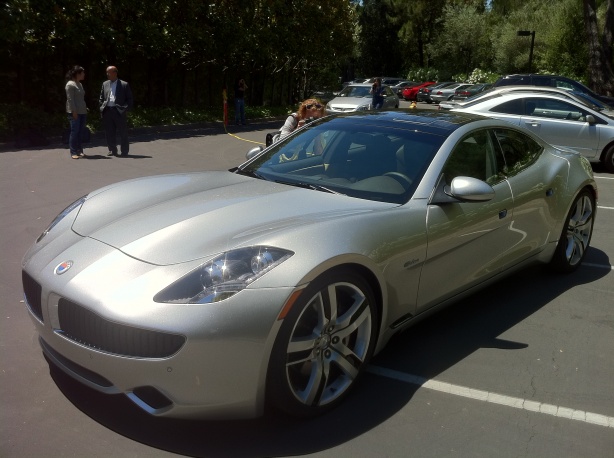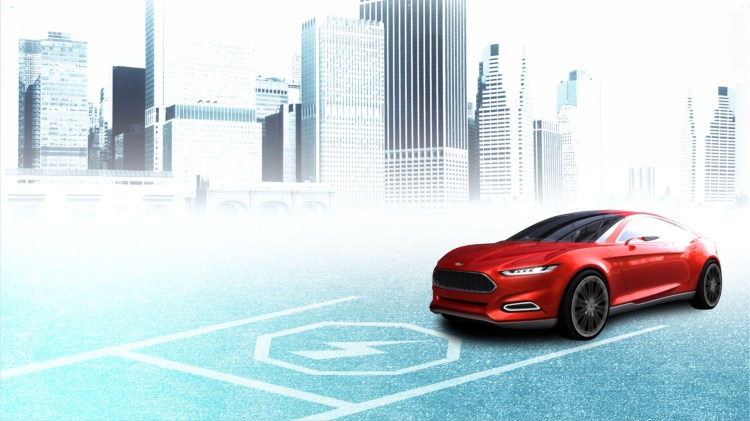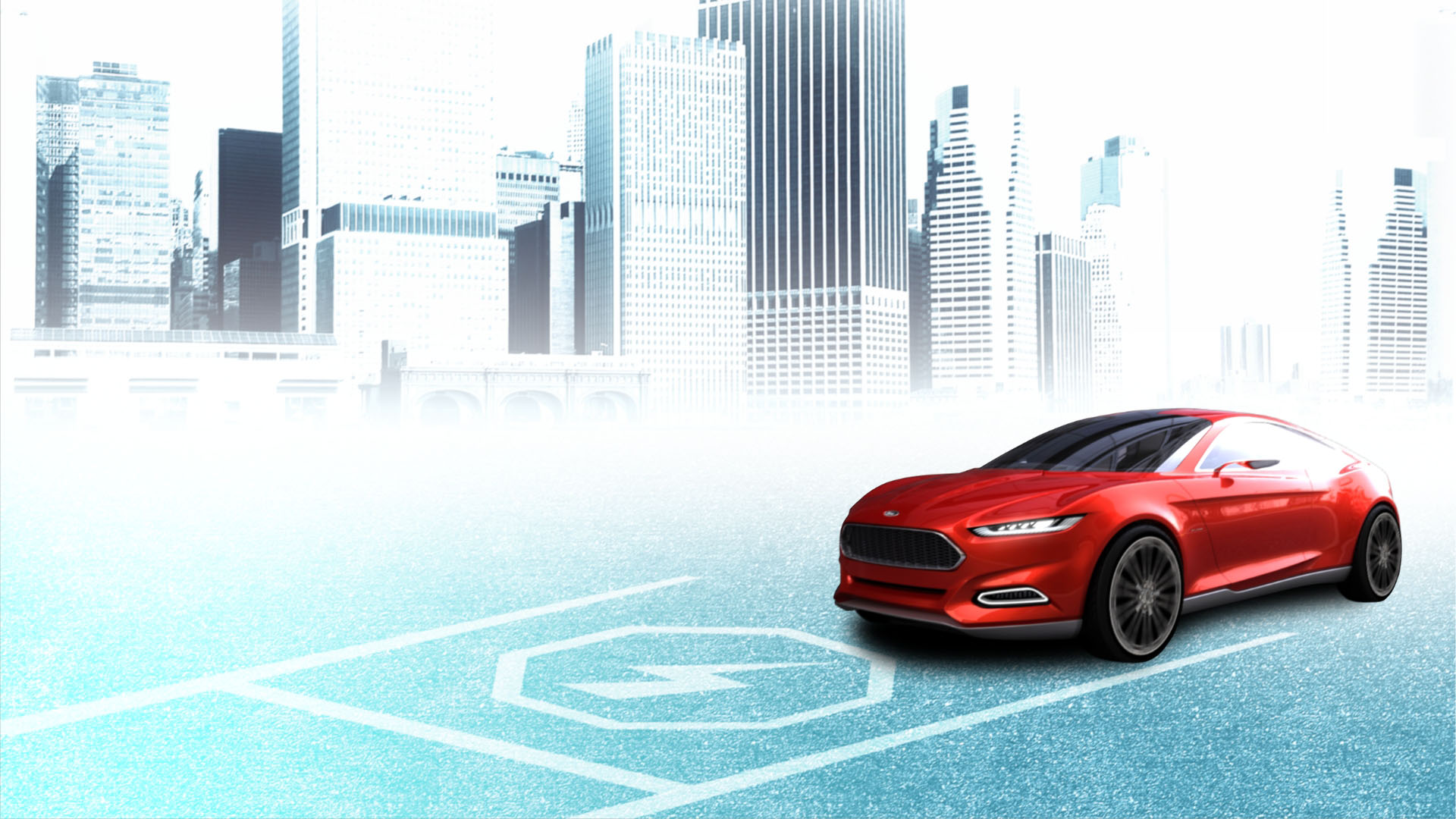A clear trend is emerging among electric car manufacturers: Plug-in hybrids are a better near-term bet than purely battery-powered cars.
Ford today unveiled the latest in its series of electric cars, a plug-in hybrid electric car called the Evos. The car has a battery-powered engine that can travel between 30 and 40 miles before switching over to an engine powered by gasoline. (Drivers can also choose whether they want to power the car solely off a gas engine, or use both the battery and gasoline to power the car.) The car also collects an enormous amount of data about your driving habits, uploads that data to remote servers, crunches it together with other drivers’ data, and supplies you with better strategies to get the most of out of your electric vehicle.
It’s one of a long line of cars that have been unveiled recently that rely on an extended-range model for electrification. The cars can travel a certain distance on an electric motor before switching over to gasoline. It’s usually a smaller range — between 25 and 50 miles — but the cars are designed to give drivers who want to drive an entirely electric car the option to do so without having to worry about running dry at any point.
Extended-range hybrid electric cars are a new breed of electric cars that differ from traditional hybrid electric cars, which run a powertrain with both electric power and gasoline. The extended-range model powers an engine entirely from battery power, and then when the battery runs dry it uses a gas-powered motor to recharge the battery and extend the range of the car. If drivers limit their driving habits, the car essentially behaves like a battery-powered electric car.
“We really feel like the plug-in hybrid is going to be the most popular for the widest variety of customers,” Ford technology communications manager Alan Hall told VentureBeat. “Hybrids today have been very successful with customers because you don’t have the range anxiety that might come from owning a battery-powered electric car.”
 Ford isn’t the only company that expects the plug-in hybrid to win out. Clean technology research firm Pike Research expects 754,000 extended-range hybrid electric vehicles to hit the road by 2017, compared to around 504,000 battery-electric vehicles. It’s around a three-to-two ratio, which should continue for the foreseeable future in the United States, Pike Research analyst John Gartner told VentureBeat.
Ford isn’t the only company that expects the plug-in hybrid to win out. Clean technology research firm Pike Research expects 754,000 extended-range hybrid electric vehicles to hit the road by 2017, compared to around 504,000 battery-electric vehicles. It’s around a three-to-two ratio, which should continue for the foreseeable future in the United States, Pike Research analyst John Gartner told VentureBeat.
That’s compared to traditional hybrids, which have become popular in recent years because they are much more fuel efficient than typical cars powered by internal combustion engines. For example, Toyota has sold 3.3 million Toyota Prius hybrids since the car came out in 1997. Pike Research is forecasting 2.75 million traditional hybrid models sold between 2011 and 2017. But traditional hybrids have a first-mover advantage over extended-range vehicles, which have only recently started to gain traction.
Here’s a list of just a few upcoming cars that use the extended-range model:
- The BMW i3 (pictured above) and i8 models both have extended-range versions.
- General Motors’ Cadillac ELR, an extended-range luxury sedan, travels around 35 miles before switching to a gasoline.
- Fisker Automotive delivered the first commercially-produced model of its luxury extended-range electric car hybrid, the Fisker Karma (pictured below), last month.
- Ford today unveiled the Evos, above.
“North America is the only region where we see plug-ins outselling battery electrics because of the mix of manufacturers and driving habits,” Gartner said. “Partly because drivers here in America tend to go further than in other parts of the world, partly because of the flexibility of having a secondary power source. We think plug-in hybrids will outsell battery electrics for the foreseeable future.”
North America is one of the largest car markets in the world, particularly in the United States, where road trips between major cities like San Francisco and Las Vegas are the norm. In my case, it’d be between Austin, Texas, and my hometown Houston, a trip that’s around 165 miles or more than 300 miles round trip. That’s a trip that far exceeds the mileage you could get out of a purely electric car like the Nissan Leaf, which is limited to 100 miles.
 Purely electric cars pose two problems for drivers: limited range and a limited infrastructure for recharging them. The first problem should eventually find a solution as battery technology matures to the point that the choice between an extended-range hybrid and a battery-powered electric car becomes a choice of personal preference, Gartner said. But the latter problem still doesn’t have a definitive solution, nor a plan for a solution, in place yet.
Purely electric cars pose two problems for drivers: limited range and a limited infrastructure for recharging them. The first problem should eventually find a solution as battery technology matures to the point that the choice between an extended-range hybrid and a battery-powered electric car becomes a choice of personal preference, Gartner said. But the latter problem still doesn’t have a definitive solution, nor a plan for a solution, in place yet.
“Long term, battery-powered electric cars have the potential to come on in force, but in order to accelerate that, you need to see a significant advancement of the infrastructure,” Volt spokesperson Rob Peterson told VentureBeat. “You’re still required to recharge that car, and even if there’s a network of fast chargers you’d have to have the flexibility to drive in certain limits — right now, people aren’t willing to make that decision.”
Cue Tesla Motors, one of the upstarts in the battery-powered electric car market. Tesla’s cars have some of the longest ranges in the industry, with the Tesla Roadster checking in at around 200 miles before it runs out of juice and the company’s upcoming car, the Model S, running around 300 miles before the battery runs dry, the company claims. The company is also working on a fast-charging procedure that it says will charge the Model S to around 80 percent battery life in 45 minutes.
“The vast majority of our customers just plug in at night when electricity is cheapest and wake up with full range available,” Tesla Motors spokesperson Camille Ricketts told VentureBeat. “We can get an 80 percent charge in just 45 minutes, makes it very realistic to be on a road trip. You just plug in while you’re eating lunch or stopping for dinner.”
The Model S (pictured below) currently runs a pricey $57,000 before government incentives for purchasing an electric car, and will be available later in 2012. Around 75 percent of the reservations for the Model S came from U.S. car buyers, while the rest came from European buyers, according to Tesla Motors chief executive Elon Musk. But Tesla Motors intends to drive the cost of pure battery-powered electric cars down to a point where any consumer can afford the car and it becomes a preference choice between battery-powered electric cars and extended-range electric cars, Ricketts said.
 Despite a strong showing of support for the extended-range electric hybrid, the Nissan Leaf has proved popular in the small but fiercely competitive market of early electric car adopters. Nissan sold 931 all-electric battery-powered Leafs in July, bringing the total number of electric cars the company has sold to 4,806. General Motors only sold 125 Volts, but it had to shut down its Detroit-based plant to retool it, bringing its total vehicles shipped to 2,870. General Motors expects to sell around 16,000 Volts by the end of the year now that the plant has re-opened.
Despite a strong showing of support for the extended-range electric hybrid, the Nissan Leaf has proved popular in the small but fiercely competitive market of early electric car adopters. Nissan sold 931 all-electric battery-powered Leafs in July, bringing the total number of electric cars the company has sold to 4,806. General Motors only sold 125 Volts, but it had to shut down its Detroit-based plant to retool it, bringing its total vehicles shipped to 2,870. General Motors expects to sell around 16,000 Volts by the end of the year now that the plant has re-opened.
In Europe, where there are more well-defined driving habits, battery-powered electric cars are set to bloom. That’s because North American driving habits cater more toward much longer ranges, like those trips between Austin and Houston, while most drivers in Europe have smaller commutes and do not take long driving trips like North American drivers are accustomed to.
“North America is the only region where we see plug-ins outselling battery electrics because of the mix of manufacturers and driving habits,” Gartner said.
Those companies mentioned above still plan on manufacturing battery-powered electric cars. General Motors, for example, has a several deals in place with battery suppliers for a battery-powered electric car the company plans to unveil later this year, Peterson said. But for the time being, those cars are geared toward a niche market that have well-defined driving habits and shorter commutes, Peterson said.
“A pure battery-powered electric car, like a Nissan Leaf, has to be positioned for the right customer and really in the right environment,” he said. “It has to be a person with a very well-defined commute or driving pattern or operates it in an area with a mature charging infrastructure — and right now that infrastructure is not mature yet.”
VentureBeat's mission is to be a digital town square for technical decision-makers to gain knowledge about transformative enterprise technology and transact. Learn More


